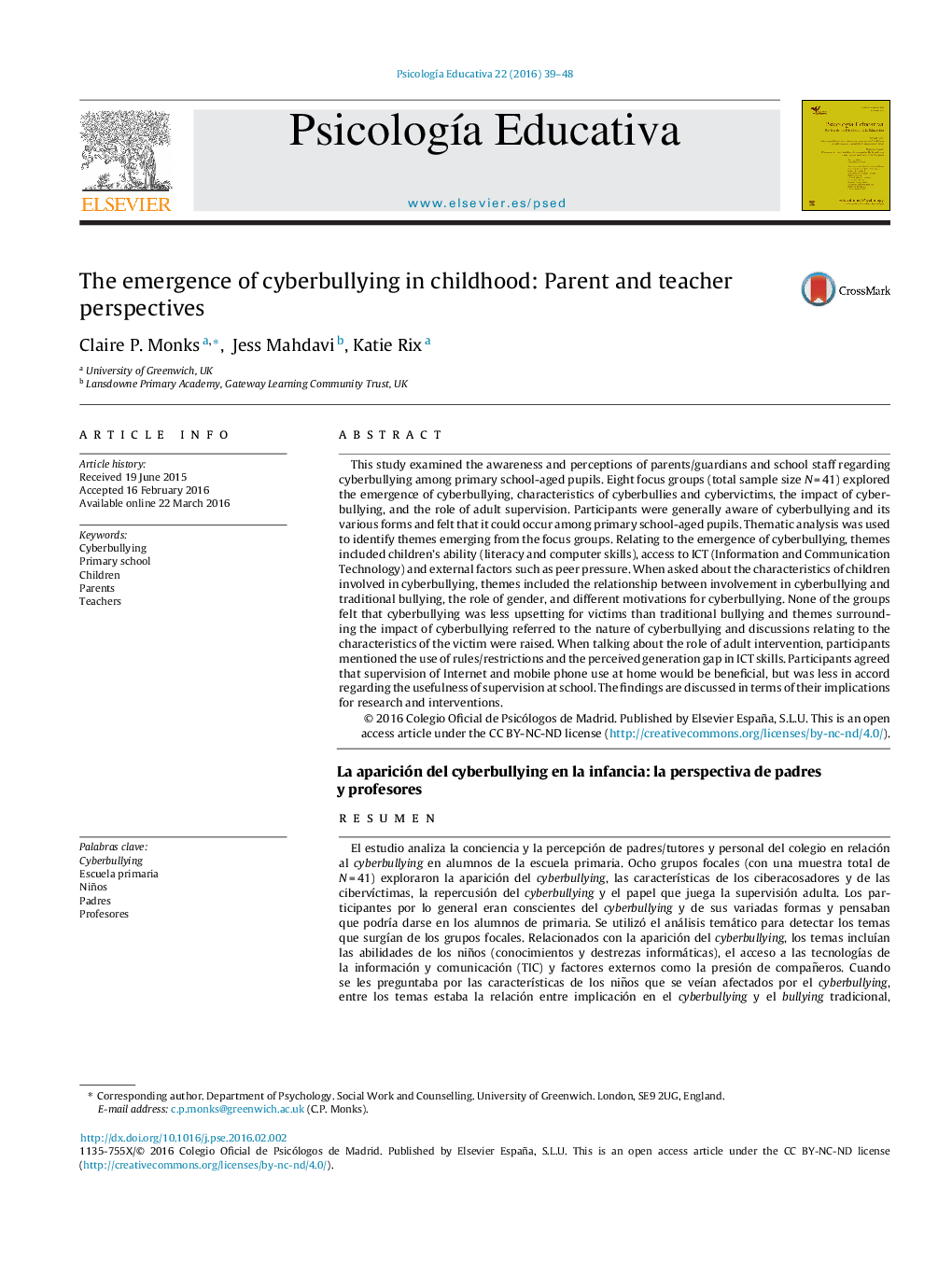| کد مقاله | کد نشریه | سال انتشار | مقاله انگلیسی | نسخه تمام متن |
|---|---|---|---|---|
| 919141 | 1370399 | 2016 | 10 صفحه PDF | دانلود رایگان |
This study examined the awareness and perceptions of parents/guardians and school staff regarding cyberbullying among primary school-aged pupils. Eight focus groups (total sample size N = 41) explored the emergence of cyberbullying, characteristics of cyberbullies and cybervictims, the impact of cyberbullying, and the role of adult supervision. Participants were generally aware of cyberbullying and its various forms and felt that it could occur among primary school-aged pupils. Thematic analysis was used to identify themes emerging from the focus groups. Relating to the emergence of cyberbullying, themes included children's ability (literacy and computer skills), access to ICT (Information and Communication Technology) and external factors such as peer pressure. When asked about the characteristics of children involved in cyberbullying, themes included the relationship between involvement in cyberbullying and traditional bullying, the role of gender, and different motivations for cyberbullying. None of the groups felt that cyberbullying was less upsetting for victims than traditional bullying and themes surrounding the impact of cyberbullying referred to the nature of cyberbullying and discussions relating to the characteristics of the victim were raised. When talking about the role of adult intervention, participants mentioned the use of rules/restrictions and the perceived generation gap in ICT skills. Participants agreed that supervision of Internet and mobile phone use at home would be beneficial, but was less in accord regarding the usefulness of supervision at school. The findings are discussed in terms of their implications for research and interventions.
ResumenEl estudio analiza la conciencia y la percepción de padres/tutores y personal del colegio en relación al cyberbullying en alumnos de la escuela primaria. Ocho grupos focales (con una muestra total de N = 41) exploraron la aparición del cyberbullying, las características de los ciberacosadores y de las cibervíctimas, la repercusión del cyberbullying y el papel que juega la supervisión adulta. Los participantes por lo general eran conscientes del cyberbullying y de sus variadas formas y pensaban que podría darse en los alumnos de primaria. Se utilizó el análisis temático para detectar los temas que surgían de los grupos focales. Relacionados con la aparición del cyberbullying, los temas incluían las abilidades de los niños (conocimientos y destrezas informáticas), el acceso a las tecnologías de la información y comunicación (TIC) y factores externos como la presión de compañeros. Cuando se les preguntaba por las características de los niños que se veían afectados por el cyberbullying, entre los temas estaba la relación entre implicación en el cyberbullying y el bullying tradicional, el papel del género y la motivación por el cyberbullying. Ninguno de los grupos creyó que el cyberbullying fuese menos molesto para las víctimas que el bullying tradicional y los temas alrededor del impacto del cyberbullying aludían a la naturaleza del cyberbullying, suscitándose debates relativos a las características de la victima. Cuando se hablaba del papel de la intervención adulta, los participantes mencionaban la utilización de reglas/restricciones y de la brecha generacional que se percibía en las destrezas en el uso de las TIC. Los participantes estaban de acuerdo en que la supervisión del uso de Internet y móvil en casa sería beneficiosa, pero estaban menos de acuerdo en la utilidad de la supervisión en el colegio. Se comentan los resultados en cuanto a su implicación para la investigación y las intervenciones.
Journal: Psicología Educativa - Volume 22, Issue 1, June 2016, Pages 39–48
